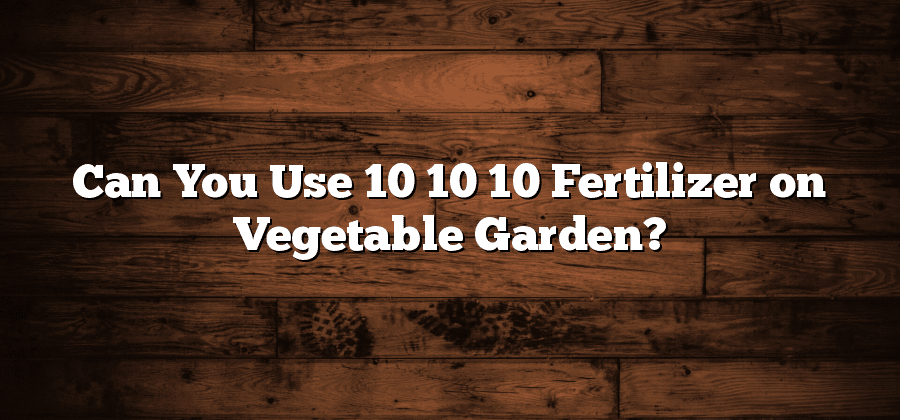Understanding 10-10-10 Fertilizer Composition
When it comes to understanding 10-10-10 fertilizer composition, it is important to first grasp the meaning behind those numbers. The numbers 10-10-10 represent the percentage by weight of the three primary nutrients found in the fertilizer: nitrogen (N), phosphorus (P), and potassium (K). In other words, a bag of 10-10-10 fertilizer contains 10% nitrogen, 10% phosphorus, and 10% potassium. These three nutrients are essential for plant growth and play different roles in supporting overall plant health.
Nitrogen is responsible for promoting leaf and stem growth, as well as encouraging the production of chlorophyll – the pigment that gives plants their green color. Phosphorus is crucial for root development, flower and fruit formation, and overall energy transfer within the plant. Potassium, on the other hand, helps strengthen plants, improves resistance to pests and diseases, and enhances tolerance to environmental stresses such as drought or extreme temperatures. By understanding the composition of 10-10-10 fertilizer, gardeners can make informed decisions on how and when to apply it to their vegetable gardens. However, it is important to consider both the benefits and potential drawbacks of using this particular fertilizer on vegetables.
• Nitrogen (N), phosphorus (P), and potassium (K) are the three primary nutrients found in 10-10-10 fertilizer.
• A bag of 10-10-10 fertilizer contains 10% nitrogen, 10% phosphorus, and 10% potassium.
• Nitrogen promotes leaf and stem growth and encourages chlorophyll production.
• Phosphorus is essential for root development, flower and fruit formation, and energy transfer within plants.
• Potassium strengthens plants, improves resistance to pests and diseases, and enhances tolerance to environmental stresses.
• Understanding the composition of 10-10-10 fertilizer helps gardeners make informed decisions on application methods.
• Consider both the benefits and potential drawbacks when using this fertilizer on vegetables.
Necessity of Fertilizers for Vegetable Gardens
In order to achieve optimal growth and abundant harvests, vegetable gardens often require the use of fertilizers. Fertilizers provide essential nutrients that may be lacking in the soil, ensuring that plants have the necessary resources for healthy development. These nutrients include primary macronutrients such as nitrogen, phosphorus, and potassium, as well as secondary macronutrients and various micronutrients. Adequate nutrient levels in the soil promote strong root development, vibrant foliage, and robust fruit production.
Vegetable plants are heavy feeders, meaning they have high nutrient requirements in order to support their vigorous growth and reproductive processes. Without proper fertilization, plants can suffer from stunted growth, nutrient deficiencies, and reduced yields. In some cases, plants may even become more susceptible to diseases and pest infestations. By providing the necessary nutrients through fertilizers, gardeners can ensure that their vegetable plants have the best chance of thriving and producing bountiful crops.
Pros and Cons of Using 10-10-10 Fertilizer on Vegetables
Pros:
Using 10-10-10 fertilizer on vegetables can offer several advantages for gardeners. Firstly, this type of fertilizer contains a balanced ratio of three essential nutrients – nitrogen, phosphorus, and potassium – which are all crucial for plant growth and development. By providing a balanced nutrient supply, 10-10-10 fertilizer can help ensure that the vegetables receive the appropriate amount of each nutrient, promoting healthy growth and higher yields.
Another benefit of using 10-10-10 fertilizer is its convenience and ease of use. This type of fertilizer can be easily purchased from garden centers or online stores, and it comes in a granular form that can be applied directly to the soil or mixed with water for foliar feeding. The straightforward application process makes it suitable for both novice and experienced gardeners alike, saving time and effort in maintaining a productive vegetable garden.
Factors to Consider Before Applying 10-10-10 Fertilizer
When considering the application of 10-10-10 fertilizer, there are several factors that every gardener should take into account. Firstly, it is important to determine the specific nutrient needs of the plants in your garden. Different plants may have different nutrient requirements, and applying a general fertilizer like 10-10-10 may not address their specific needs. Conducting a soil test can be a valuable tool in understanding the nutrient composition of your soil and identifying any deficiencies or imbalances that may exist.
Another factor to consider is timing. It is crucial to apply fertilizer at the right time for optimum results. For most vegetables, it is recommended to apply fertilizer at planting time and then again at regular intervals throughout the growing season. However, excessive or untimely application of fertilizer can lead to negative consequences such as burning or stunting the plants. Understanding the growth stages of your vegetables and the appropriate time for fertilizer application can help ensure that the nutrients are available when the plants need them the most.
Soil Testing: Determining Nutrient Imbalances
Soil testing is an essential step in determining the nutrient imbalances present in your garden soil. By understanding the specific nutrient deficiencies or excesses, you can effectively tailor your fertilizer application to meet the needs of your plants.
One of the main advantages of soil testing is that it provides a precise analysis of the nutrient levels in your soil. This information is crucial for selecting the appropriate fertilizers and amendments to ensure healthy plant growth. Additionally, soil testing can help prevent over-fertilization, which can lead to nutrient runoff and environmental pollution. By identifying nutrient imbalances, you can optimize your fertilization practices and promote sustainable gardening techniques.






